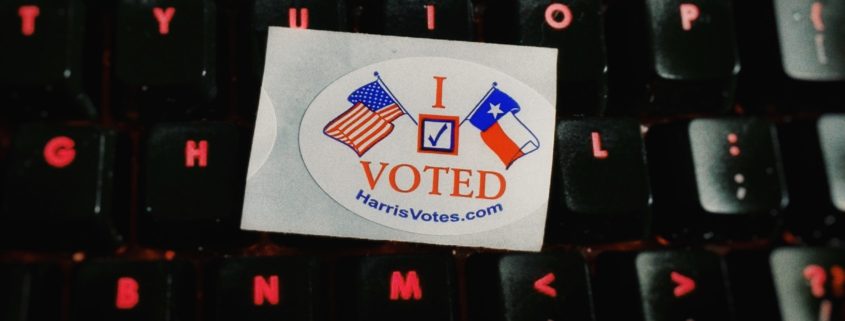“I Voted” Stickers as a Native Ad Campaign: Is It Worth It?
Since Michael and I took some time off last Thursday to vote, the “I Voted” stickers have been on my mind. What’s their value? Could that money be used better elsewhere? Is it actually a strong enough voting incentive for it to be worth diverting that slice of state budget? Should we view these as a form of native ad?
Monetary Value of “I Voted” Stickers
I did a little bit of research, and I found an article stating that in 2016, the state of Oklahoma spent approximately $0.003 on each sticker. That’s a very reasonable per-unit price, but how much does it become in aggregate? For Oklahoma, at 2,030,277 registered voters, the answer is $6,090.83. That’s like the cost of a home air conditioning unit, so, no, the sticker budget wouldn’t go very far toward anything.
But what about a more populous state? According to the Texas Tribune, there are 15,015,700 registered voters. Assuming the same price Oklahoma pays for stickers, that’s $45,047.10. So, no, that’s still not really enough to do anything at a state level. It’s maybe one lower-level employee salary, so unless we desperately need more papers pushed around, I don’t think it’s going to go very far.
Psychological Value of “I Voted”
So maybe the value isn’t the kind that could fix underfunded schools and poorly paved roads. I won’t say that isn’t a little disappointing. I like reallocating budgets to more needed or better working programs (it’s what I do for a living, after all). This is a native ad. No way around it.
Oh, come on. You knew I was going to go there eventually.
“I Voted” Stickers as Social Currency
According to a 2012 article in The Atlantic, “emphasizing high [voter] turnout is more likely to motivate marginal voters” because people want to be part of a group. Basically, as a form of social currency, we couldn’t be doing better. You get seen voting, you get your sticker, and then you go back to your daily life, marked as an active voter. You did your part, and you’re advertising what you view to be important–civic duty. At the same time, though, you’re also advertising that voting doesn’t take so long that you can’t go grab lunch at Chipotle. It’s kind of ingenious, and it may be one of the few forms of printed branding and awareness ads that you can see working. How many times have you shown up somewhere with your sticker, only to hear, “I need to go vote today,” as you walk past?
More interestingly, people complain when they don’t get their sticker. In our increasingly online and visually oriented world, this makes sense. Without your sticker, what are you going to put on Instagram? The signs in front of the polling station? Anyone walking by can get that, and you sure can’t take a pic of you actually submitting your ballot.
“I Voted:” A Preliminary Post-Mortem
Given that we know the cost and we know the increase in the number of voters in Texas from the 2012 election to now, can we say this native campaign works? To be sure, an increase from 13.6 million to 15.1 million voters within 4 years (2012-2016) is significant–that’s an 11% increase in one presidential election cycle. That said, we can’t account for how much of that was due to the candidates and how much was due to the sticker. Let’s assume, though, that we’re looking at this in a bubble. At an increase from election cycle to election cycle of 1,500,000, was the additional $4,500 in stickers worth it?
I don’t know about you, but my Facebook feed has been full of nothing but early voting posts and pictures of the sticker. If we view voting as a click instead of conversion (since we can’t know the conversion rates of this election), then:
- If only 12,100 people of the 15.1 million voters in Texas post about voting and cause someone else to vote, that’s better than the industry click-through average on digital display ads.
- If 302,000 voters lead to another person voting, that’s the same performance as the average search marketing campaign.
Considering that these campaigns would cost a lot more than $45,047.10 over four years, I’d say Texas is looking downright frugal on a pretty effective native advertising campaign. Most native campaigns I’ve seen would have blown through our estimated budget in 2-4 months, maybe less.




Leave a Reply
Want to join the discussion?Feel free to contribute!